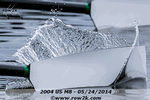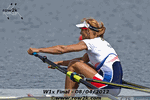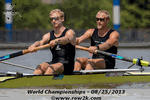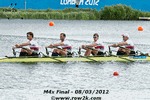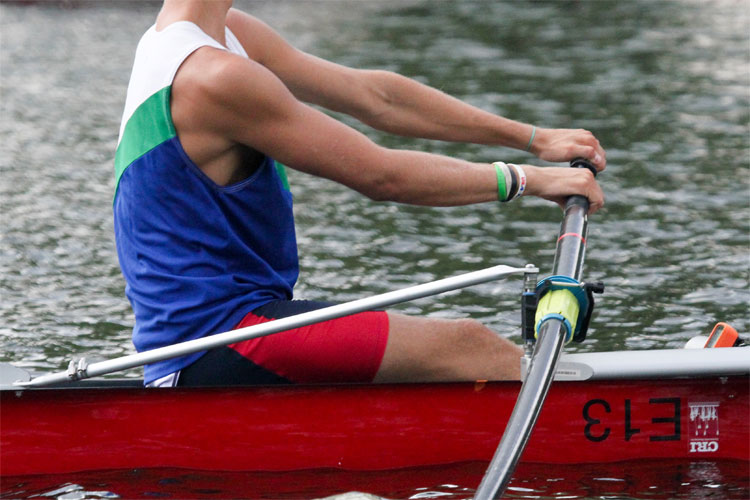
It's a huge benefit if you can watch Olympic and World Championship rowers at slow speed or even frame by frame. These observations can help you develop an understanding of an "ideal" technique and that we have been describing in this recent series of articles. Most rowers and coaches are always looking for ways to make boats go faster. One of the best ways to achieve this is in trying not to slow the boat down, which is why last month we wrote about the importance of body motion out of bow.
There are two major ways to influence the motion of the boat. One is weight on the oarlock/pin and the other is weight on the foot stretcher. Weight on the pin provides a force in the direction that we want the boat to move. Weight on the foot stretcher alone will move the boat backward. The goal has always been to maximize the force on the oar/pin during the drive.
Many systems have been set up over the years to allow rowers and coaches to visualize this information. As early as the 1970s, some schools set up systems in their rowing tanks using strain gauges on the oar and then displaying the force curve on an oscilloscope. More recently, Concept II shows a force curve as one of their displays on the ergometer. Coaches have talked for years in terms of how to change that curve for maximum effect.
A less-studied factor was the correlation between the weight on the oar and the weight on the foot stretcher because it was not easily measured without more cumbersome systems of full-shell wiring, such as those used for years by the German national teams in their "Messboote," or "Measurement Boat" setups.
Now smartOar has come up with a system to measure both at the same time. We have seen data from the system though we have not had the opportunity to row with it, so can't endorse it specifically, but some of the graphs generated by the system can illustrate some relevant points here.
What is fascinating is that now there is the ability to try different techniques to reduce the weight on the foot stretcher further into the recovery. We know that weight will come onto the soles of the feet and de-accelerate the hull of the boat, the question is how early, how much and what can we do to reduce it?
One idea that is to establish body angle by 1/3 to ½ slide and then literally pulling the thighs to the chest, or stomach for some of us, by using the hip flexors. The goal is to do active work to try to get the feet out of the way so that the boat can continue to run into the catch. At the catch, weight will come on the foot stretcher and hopefully, the rower can get it on the oar as soon after that as possible. That lightness at the catch is a very important goal as we want the boat to be able to continue to run underneath us. Therefore it is a much better goal to think "light" on the recovery/slide instead of "slow." More information about the effect of body mass on the boat will allow for development of a more efficient rowing style. 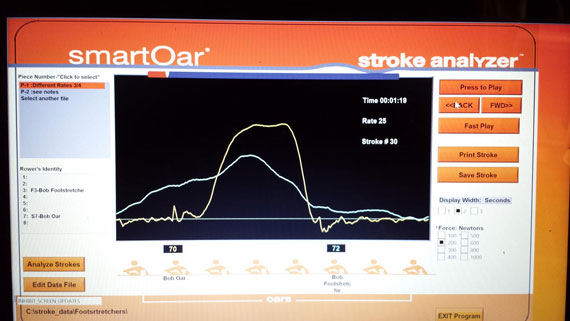
Looking at the graphs of data from the smartOar system shows this. The graph that is being displayed is one random stroke that we have chosen, each stroke varies. The yellow line represents force on the oar during the stroke cycle, the blue line represents weight on the foot stretcher during that same stroke. The foot stretcher force is being measured on the top bar but not at the heels, hence the difference of magnitude between the two forces. It would be interesting to see a third curve showing weight on the heels.
Among elite rowers, one observation is that the rowers look more relaxed, less rushed, with the catches less forced, despite the fact that most crews are rowing at 35 - 36 strokes per minute, or higher. One can observe light catches despite high stroke rates as rowers attempt to keep weight off the foot stretcher before applying pressure on the pin. That sequence of light movement into the stern followed by a solid power application is ideal in maximizing boat speed.
If you enjoy and rely on row2k, we need your help to be able to keep doing all this. Though row2k sometimes looks like a big, outside-funded operation, it mainly runs on enthusiasm and grit. Help us keep it coming, thank you! Learn more.
- Bont Rowing
- Calm Waters Rowing
- Concept 2
- Craftsbury Sculling
- The Crew Classic
- CrewLAB
- Croker
- Durham Boat Co.
- Empacher
- Faster Masters
- Filippi
- Fluidesign
- h2row.net
- HUDSON
- Live2Row Studios
- Nielsen-Kellerman
- Oak Ridge RA
- Peinert Boat Works
- Pocock Racing Shells
- Race1 USA
- RowKraft
- Rubini Jewelers
- Vespoli USA
- WinTech Racing
- Bont Rowing
- Calm Waters Rowing
- Concept 2
- Craftsbury Sculling
- The Crew Classic
- CrewLAB
- Croker
- Durham Boat Co.
- Empacher
- Faster Masters
- Filippi
- Fluidesign
- h2row.net
- HUDSON
- Live2Row Studios
- Nielsen-Kellerman
- Oak Ridge RA
- Peinert Boat Works
- Pocock Racing Shells
- Race1 USA
- RowKraft
- Rubini Jewelers
- Vespoli USA
- WinTech Racing




